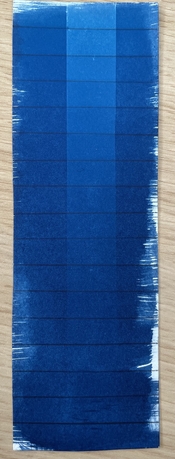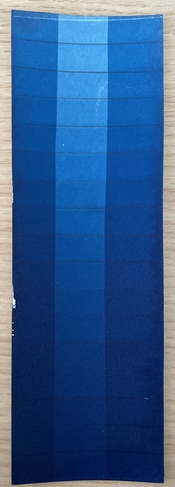largo
Member
- Joined
- Jun 22, 2009
- Messages
- 61
- Format
- Medium Format
Hello !
I am returning to cyanotypes (after a decade of not doing it), so I am re-calibrating my baseline exposure time by gradually exposing a test strip...
I am testing two formulas:
- the 1842 "original" formula in two bottles A + B
- and Mike Ware's "New Cyanotype" formula of 2019 (see https://www.mikeware.co.uk/mikeware/downloads/SimpleCyan.pdf).
I am very happy with these 2 formulas, especially the Simple Cyanotype in one bottle which gives very dense and smooth blue shadows !
Nevertheless, I am very surprised by the extremely long exposure time to reach the densest blue under a digital negative, with both formulas !
After 1h20 (!!) of exposure under my UV light source (8 UV tubes), I still do not reach the maximum density (the deepest blue)
=> see the attached scans of the test strips, the lighter area in the middle is the one under a transparent OHP film strip. The darkest step has been exposed for 1h20min !
Now, you are going to tell me that it depends on my UV light source, I agree, but all other things being equal (paper, brand of OHP transparency film, exposure unit, distance source<->contact printing frame), my basic exposure time for kallitypes or platinum / palladium prints is around 12 to 15 minutes only... !
My questions are the following:
- Is it normal that cyanotype is so slow? I have the feeling that I will have to expose my cyanotype prints for 2 hours to reach the maximum densities..... !?!
- Moreover the New Cyanotype is supposed to be faster than the "classic" cyanotype, but I don't see any difference? How to explain it ?
Thank you very much in advance for your feedback, advices & tips !
Best regards,
Loïc
I am returning to cyanotypes (after a decade of not doing it), so I am re-calibrating my baseline exposure time by gradually exposing a test strip...
I am testing two formulas:
- the 1842 "original" formula in two bottles A + B
- and Mike Ware's "New Cyanotype" formula of 2019 (see https://www.mikeware.co.uk/mikeware/downloads/SimpleCyan.pdf).
I am very happy with these 2 formulas, especially the Simple Cyanotype in one bottle which gives very dense and smooth blue shadows !
Nevertheless, I am very surprised by the extremely long exposure time to reach the densest blue under a digital negative, with both formulas !
After 1h20 (!!) of exposure under my UV light source (8 UV tubes), I still do not reach the maximum density (the deepest blue)
=> see the attached scans of the test strips, the lighter area in the middle is the one under a transparent OHP film strip. The darkest step has been exposed for 1h20min !
Now, you are going to tell me that it depends on my UV light source, I agree, but all other things being equal (paper, brand of OHP transparency film, exposure unit, distance source<->contact printing frame), my basic exposure time for kallitypes or platinum / palladium prints is around 12 to 15 minutes only... !
My questions are the following:
- Is it normal that cyanotype is so slow? I have the feeling that I will have to expose my cyanotype prints for 2 hours to reach the maximum densities..... !?!
- Moreover the New Cyanotype is supposed to be faster than the "classic" cyanotype, but I don't see any difference? How to explain it ?
Thank you very much in advance for your feedback, advices & tips !
Best regards,
Loïc





 (
(
